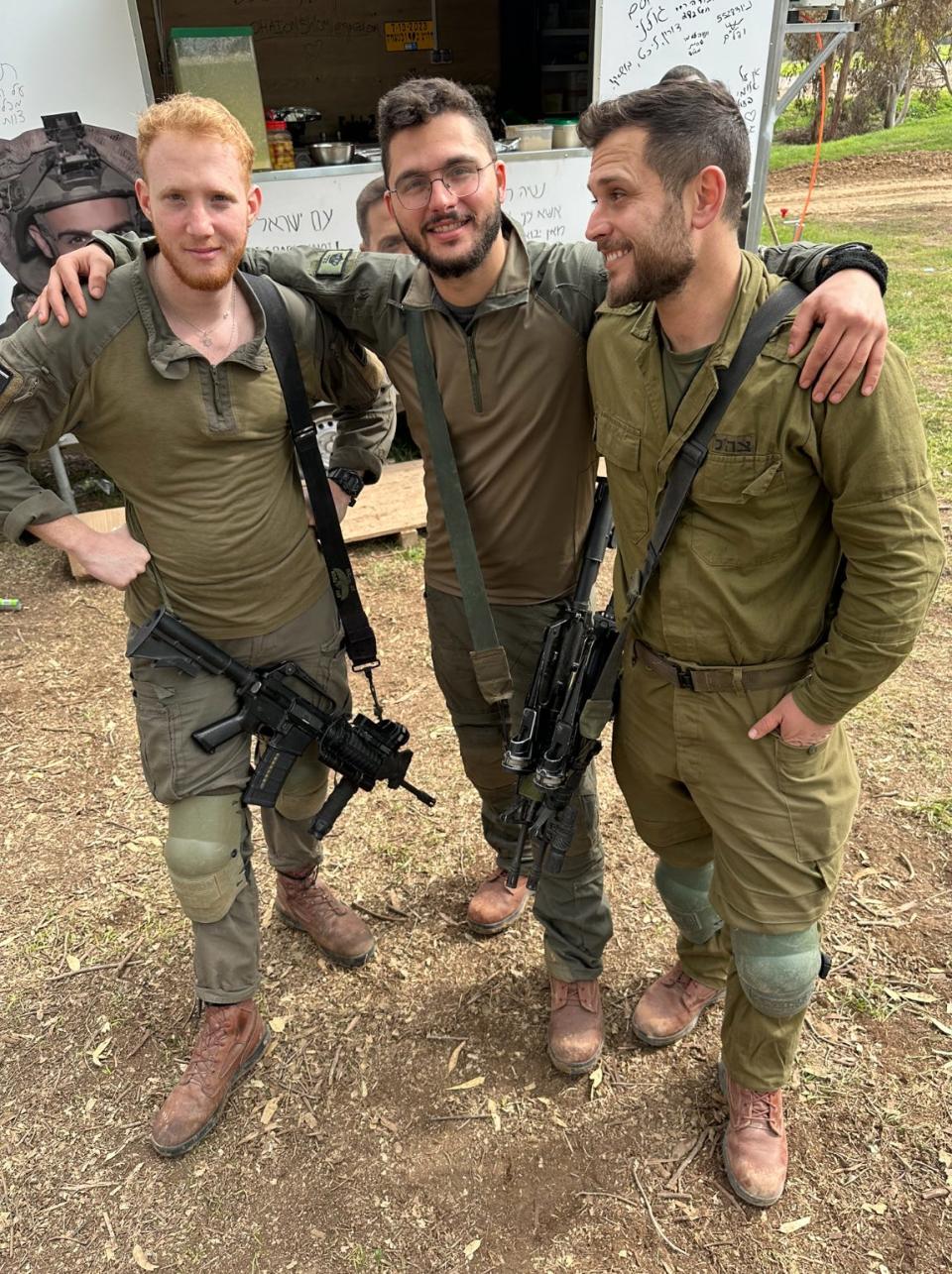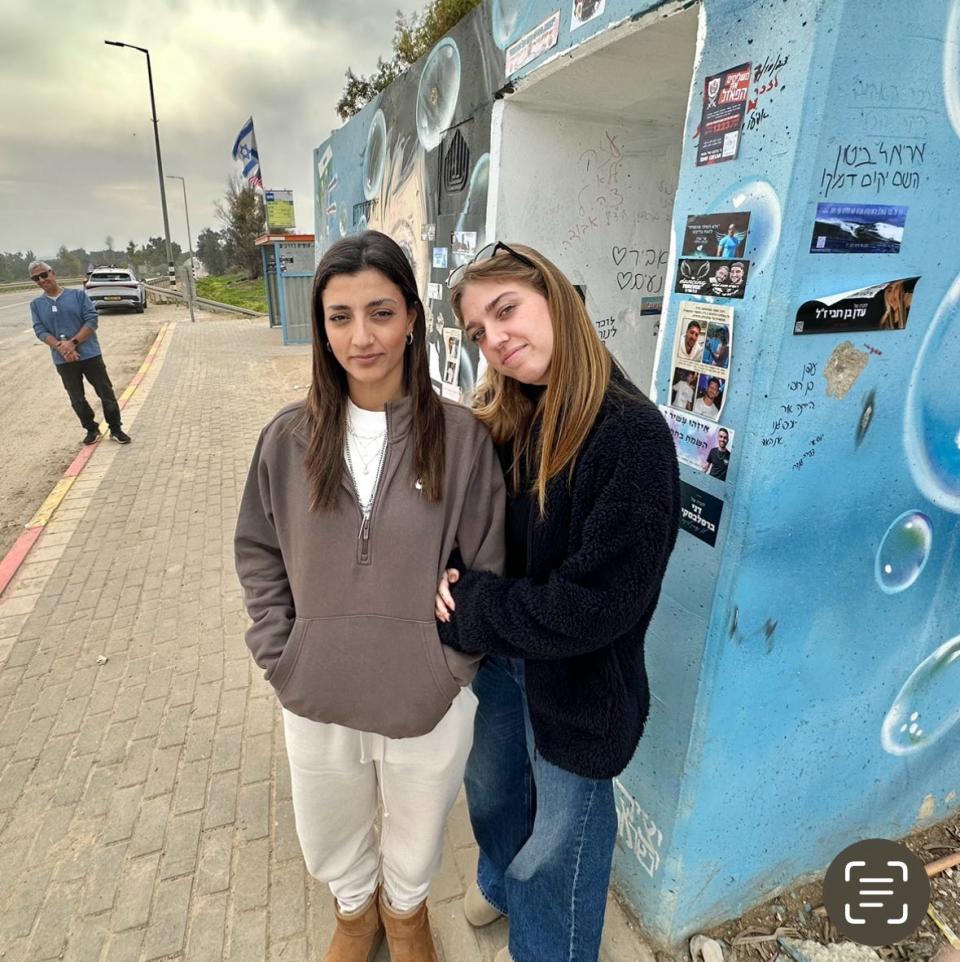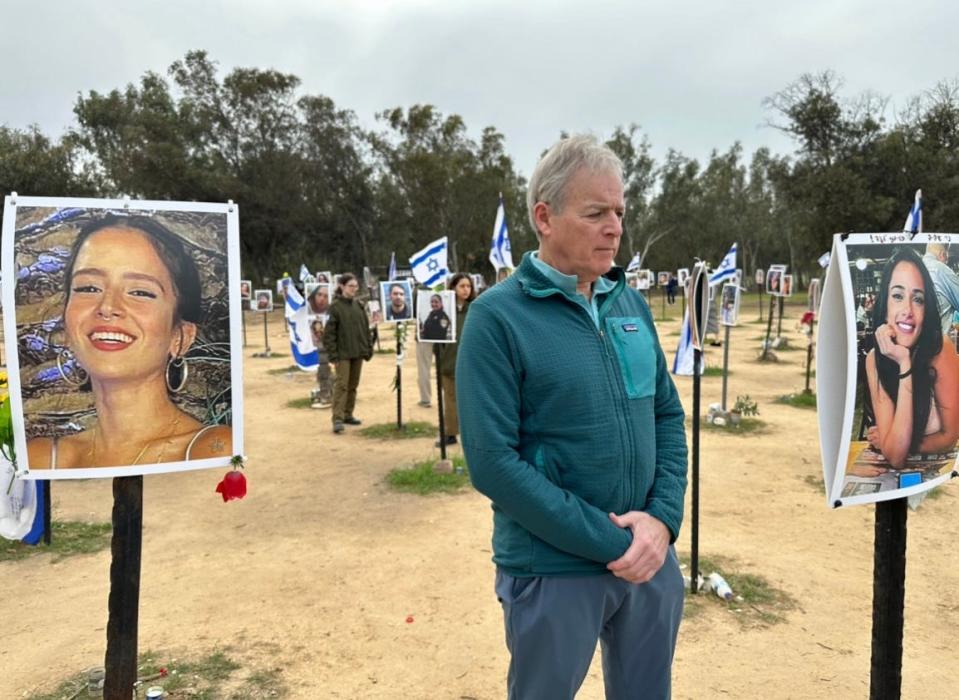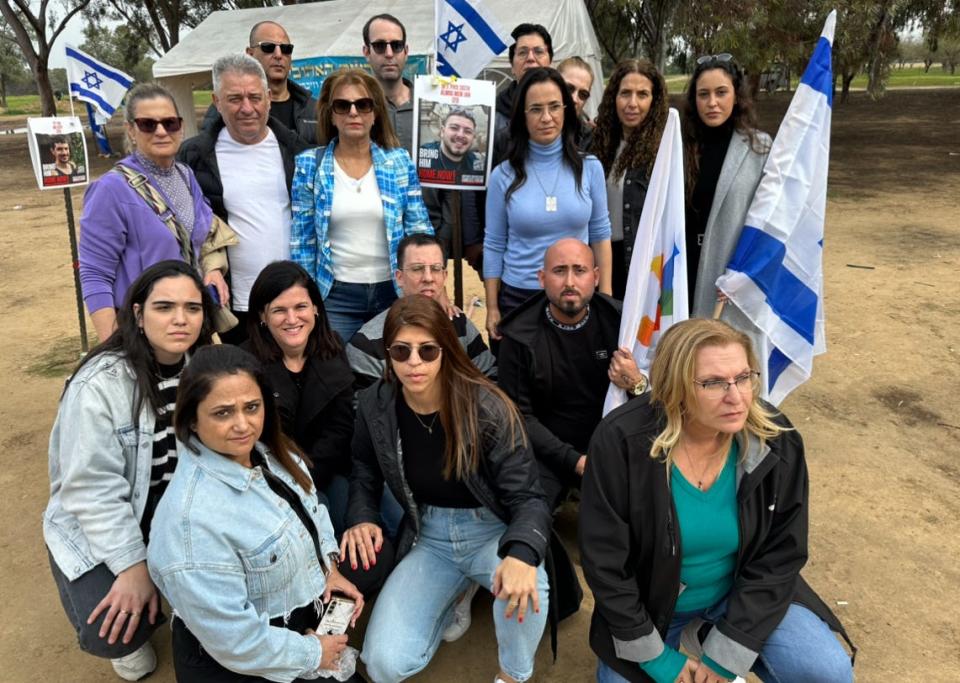Mark Patinkin in Israel: Finding courage at the site of the Nova music festival
- Oops!Something went wrong.Please try again later.
And now I am heading into the Gaza envelope, the swath of towns where it happened. Where, in better times, tourists came each winter to see red buttercups blanket the landscape. Where kibbutz dwellers welcomed Gazan workers and believed Arab and Jew could be neighbors.
That was the hope.
From the east, the land of Israel begins as a desert by the Dead Sea, rising like Tuscany into the limestone hills of Jerusalem, then lays back down into green flatlands near Gaza and the Mediterranean.
It’s a lovely but now broken part of the country.
It takes two hours to get there from Jerusalem, and I’m driving into it now with a journalist’s guide named Robby Berman, just the two of us. He tells me to keep in mind which direction Gaza is – if a siren goes off, we should crouch by a wall facing it, or even a curb.

Indeed, during our day, Robby’s phone will sound several rocket alerts, but each turns out to be from elsewhere in the country. The warnings are from the government, of course, but folks here also have backup rocket apps on their phones. Robby has two. One is called Red Alert, the other is Missile Command. That’s what living in Israel is like in 2024.
Suddenly, one of the apps goes off again, a robotic voice saying, “Missile launched.”
Robby checks the app and sees it’s far away.
“We’re fine,” he says.
We pass banana trees covered by netting, and orange groves, and now we’re in the envelope’s greenest part, lush with the smell of citrus.
Many Palestinians lived in this part of Israel before the conflict of 1948 pushed them out, which is what happens in war, but 75 years and three generations later, those now in Gaza, where their ancestors fled, hold onto the dream of return. Which is why this goes on. And on.
I have two things I want to see this day. First, the site of the Nova music festival, where an astonishing 364 people were slaughtered. Then, Kibbutz Be’eri, the worst hit of such communities with 100 butchered.
I am within miles of the Nova site when I see a typical Israeli structure by the roadside. It’s a concrete bomb shelter, a dozen folks gathered around it, so we pull over to join them. The shelter is perhaps 15 feet square, no door, just an open egress with a turn, like a doorless public restroom, except blast-proof.

Many died in such places, hoping they would be refuges, but then they were found inside. In some cases, hand grenades were thrown into their midst by Hamas members who, after a few seconds of the smoke clearing, walked in and shot the wounded.
The dozen who are here have stopped in part to pay respects, but there’s something else at play too, a sense that witnessing where it happened is a form of honoring the lost.
Outside, I approach two young women – Rotem Yaacovi, 24, and Lina Orlov, 23. They tell me they were at Nova. This is the first time they’ve been ready to visit. It was too hard before this.
I ask how they survived that day.
They simply began to run, they said, never pausing, eventually reaching their car, which was far away. Unlike others who stopped driving at the wrong times, thinking Hamas members on the road might be Israeli security, they kept going when the intruders waved them down, then shot at their car.
There’s a single big road in and out of Gaza, and somehow, Rotem and Lina sensed it wasn’t safe, so they turned off into a field, leaving the car behind, running a long time before hiding for eight hours.
“We saw bodies, said Rotem. “We saw burnt cars. We saw everything.”
I asked how they’re doing. Rotem smiled and mentioned the scene in the TV show “Friends” where Ross is a mess but keeps insisting “I’m fine.” That’s what Rotem and Lina tell people, that they’re fine, even though they’re not.
Now we pull into the entry lot of the Nova site. The red buttercups, called anemones, are salted through nearby grasses. As we step out, there’s a concussive blast from the direction of Gaza, only a few miles away. Robby says this one sounded more like the Iron Dome than a war explosion, but it could be either.
There are many cars at this shaded entry lot, and even more a quarter-mile distant. That seems to be the main memorial site.
But we pause here because there’s a food truck serving a dozen or so Israeli soldiers who tell us they’re rotating out of Gaza. I approach two of them – Ofek Kirpi and Yonatan Sela Havatzelet, both 22. They carry automatic rifles. They’d been inside a month and a half.
Were they in many firefights?
“It’s all the time,” says Ofek, often at close quarters, but much of their job was to fire support mortars, smoke for cover, flares for light or explosives.

Another soldier named Charlie Lanin joins us, age 30, born in Riverdale, Long Island, moving here with his folks when he was young.
Charlie is studying accounting at Hebrew University, but that will have to wait until the end of the war, whenever that will be. Gaza is already one of Israel’s longest conflicts, and no one here feels it will finish soon.
Charlie has a one-and-a-half-year-old and a pregnant wife at home. But he is all right with having been called up.
“This,” says Charlie, “is where I’m supposed to be.”
Jews, he explained, need a secure country to be safe. History has shown that. Last October showed it again, he said. That’s why he fights.
I tell them to stay safe and we head back to the car.
“Keep faith in God,” says Charlie.
We drive a few hundred yards forward and finally are at the heart of the site. It’s marked with an array of posters of the lost on metal posts driven into the hardpacked dirt of a former parking area. With the passing of months, circles of grass have formed around the bottom of each post.
The faces on the signs are strikingly attractive, this having happened in their prime. Dozens of visitors walk among them. A few, like the two young women at the roadside shelter, tell me they’d been wanting to visit since Oct. 7 but couldn’t.
“We didn’t have the courage until now,” one says.
I approach a group of about 20 around the poster of a young man named Almog Meir Jan. Almog is among the kidnapped. The group is here from Almog’s hometown of Or Yehuda, not far from Tel Aviv, hours away. A woman named Liat Shulhat, the town’s mayor, is leading the visit. She says this is their way of telling Almog that his hometown has not forgotten him.

“He’s constantly on our mind,” Liat says.
You can see why they chose this site for a music festival. It’s a beautiful area, shaded with stands of eucalyptus. It is quiet this day, visitors alone with their thoughts as they move from poster to poster. Few react to the occasional booms from the direction of Gaza. You get used to it.
After 10 minutes, I walk on my own into a nearby stand of trees. They are spaced 20 or so feet apart, not suitable for hiding, and you wonder, where would you run?
The floor of this treed area is covered with finger-sized pieces of eucalyptus bark, shredded to make way for the new. The sun is trying to break through a muted haze, but it’s unable to. Up ahead, deeper into the trees, I see some shrines, like those by American highways, and I go to them.
All have photos with the lifespans of the murdered, birthdates different, but end of life all the same in the European fashion: 7.10.2023.
Mark Patinkin in Israel: Traveling along the West Bank shows the price paid during conflict
Despite the knowledge of what happened, there is enough peacefulness here that you don’t want to leave.
But I have one more stop, to the worst-hit Kibbutz, Be’eri, only 10 minutes distant. Even as a journalist, it was hard to arrange a tour there – so many want to come see. And out of respect, only so many are allowed.
I was told I will find the kibbutz just as Hamas left it 102 days before, except for the removal of the bodies.
We head out of Nova, through the lush green of the Gaza envelope, grasses dotted with red anemones, on our way to see the worst of the attacked communities.
Mark Patinkin is traveling to Israel personally and is not sponsored by or affiliated with any organization. He will report firsthand from the region as he has done for the last four decades through his award-winning journalism. He can be reached at mpatinki@providencejournal.com.
This article originally appeared on The Providence Journal: Nova music festival attack remains on Israeli's minds

